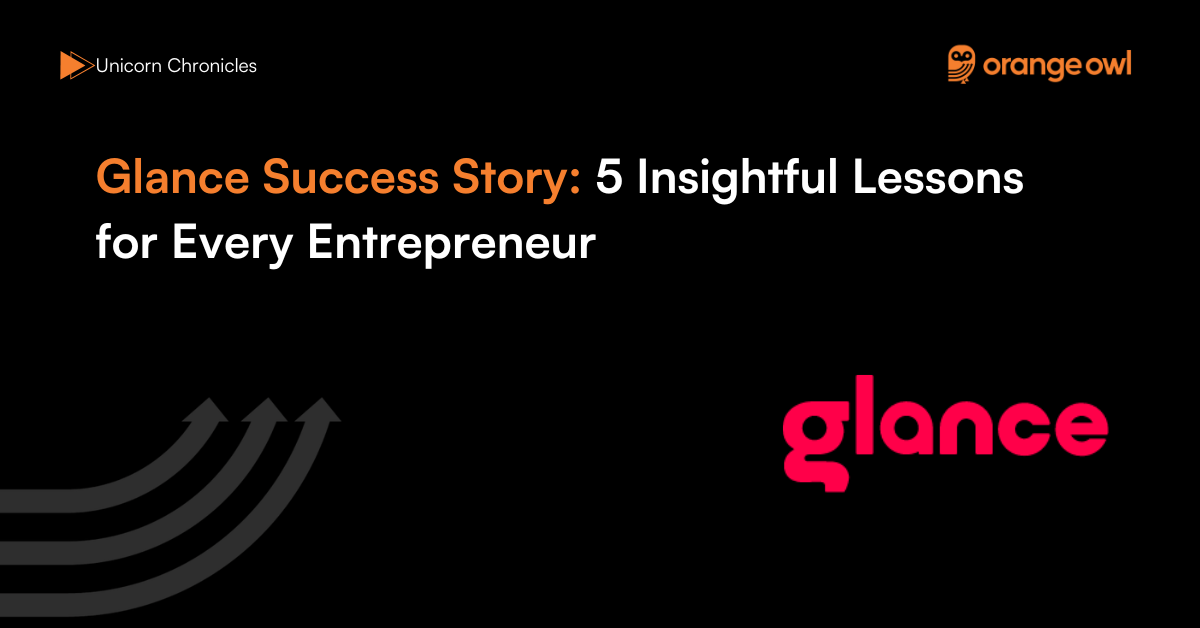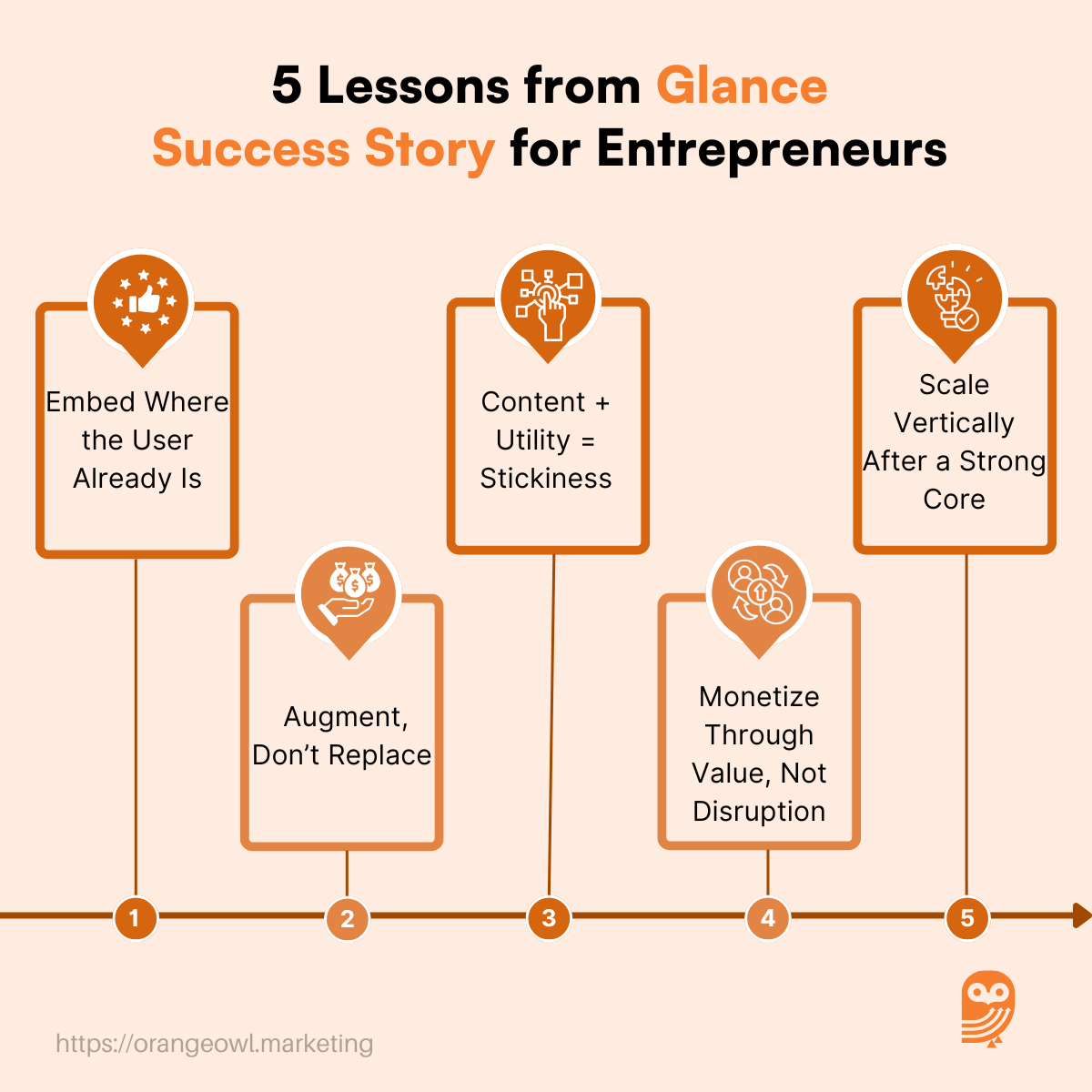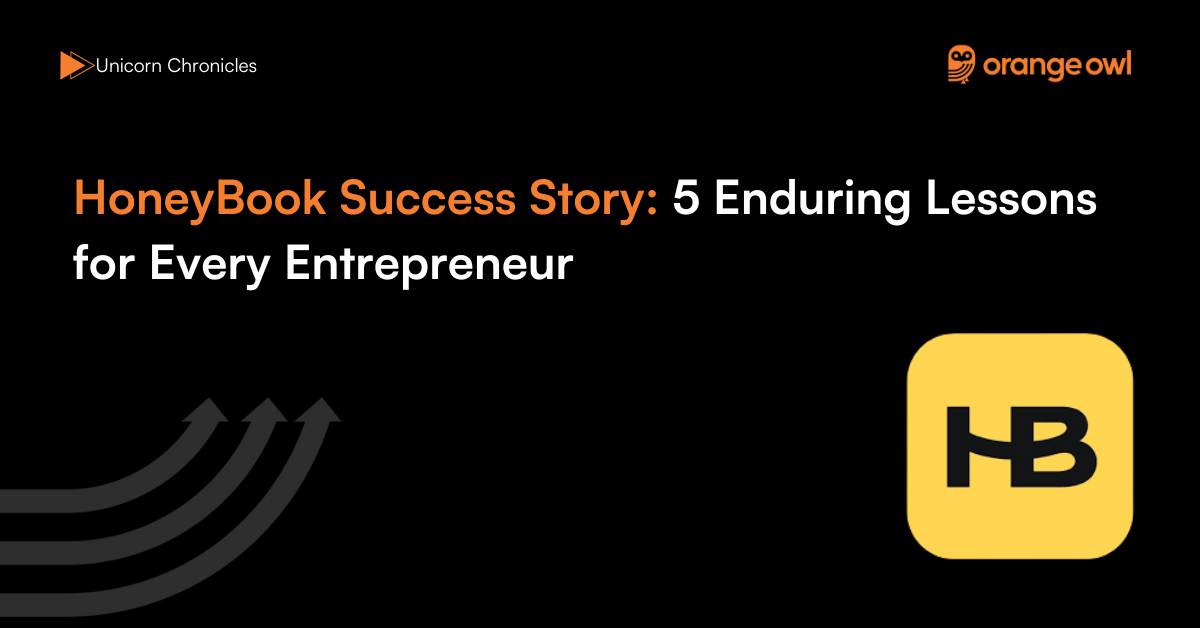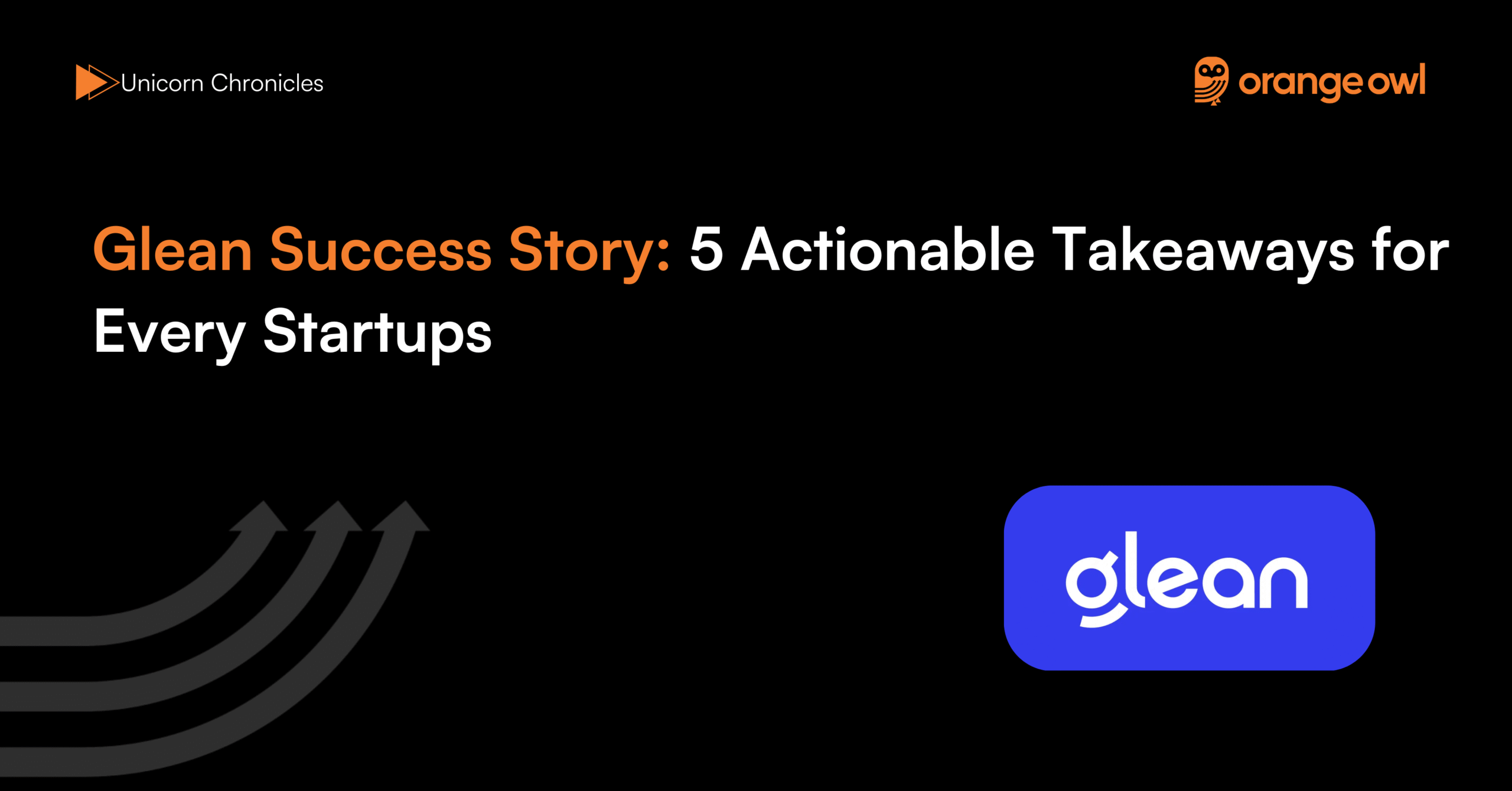Glance Success Story: 5 Insightful Lessons for Every Entrepreneur
Vivek Goel
June 11, 2025

Table of Contents
Introduction
What if the first thing you see on your phone—your lock screen—wasn’t just a static image, but a smart gateway to news, entertainment, shopping, games, and more? That’s the vision that Glance, an AI-driven content discovery platform based in Bengaluru, brought to life in 2019. As a part of the InMobi Group, Glance set out to transform the most underutilized space on smartphones—“screen zero”—into a dynamic and monetizable canvas that engages users before they even unlock their phones.
Glance has grown into a digital juggernaut with over 300 million monthly active users, and its platform comes pre-installed on more than 450 million smartphones from top OEMs including Samsung, Xiaomi, Vivo, Realme, and Motorola. In a short span, it has redefined how content is consumed, curated, and commercialized on mobile devices. In FY24, Glance recorded a revenue of Rs 614 crore (~$73 million)—a staggering 3.4× increase since FY22—demonstrating the strength of its innovative business model and user-centric approach.
In a candid interview, Naveen Tewari, Founder and CEO of InMobi Group, summed it up perfectly:
“We saw something unique about the lock screen… it was the most frequently visited screen that no one was innovating on. We decided to reimagine how content and commerce could co-exist in a non-intrusive, intelligent manner.”
What sets Glance apart is not just its massive scale, but its ability to seamlessly merge AI, content, commerce, and contextual relevance—all on the lock screen. It’s not just an app; it’s an ecosystem that engages users passively but deeply, reshaping the mobile experience as we know it.
Origin Story
The inception of Glance can be traced back to the 2015–2018 period, when the InMobi founding team began exploring how smartphones could deliver content in a more intuitive, native manner. While the rest of the world focused on apps, they identified an untapped opportunity in the most frequently accessed but underutilized real estate of a smartphone—the lock screen.
The team experimented with various prototypes and user experiences during these early years. The idea was bold yet simple: deliver rich, personalized, and contextual content directly to the lock screen—without requiring users to download apps, create logins, or even unlock their phones. This frictionless experience was a core part of their philosophy: instant content, zero effort.
In September 2019, Glance received its first major validation when it raised $45 million from Mithril Capital, a firm co-founded by Peter Thiel. The momentum accelerated in November 2020, when Google and Mithril Capital jointly invested $145 million, valuing Glance at over $1.2 billion. This funding milestone made it the second unicorn from the InMobi Group, following InMobi’s own success in the adtech space.
Backed by visionary leadership, strong technical infrastructure, and deep OEM partnerships, Glance evolved from a concept into a platform that changed how users interact with their devices—shifting engagement from app-first to content-first.
Business Landscape and Early Challenges
At launch, Glance entered a fiercely competitive digital content landscape, filled with short-video apps, streaming platforms, news aggregators, and social media giants. Yet, the team found a white space no one was tapping into: “screen zero”—the lock screen.
Instead of competing for attention after users unlocked their phones, Glance won attention before the phone was even opened. This strategic positioning was reinforced by deep partnerships with top smartphone OEMs like Samsung, Xiaomi, Vivo, Oppo, Realme, Jio, and Motorola, allowing Glance to be pre-installed on hundreds of millions of devices. It bypassed the usual discovery friction of app stores and started capturing user attention from day one.
Within 21 months, Glance achieved over 100 million daily active users (DAUs), with users spending an average of 25 minutes daily engaging with its content. Notably, over 30% of interactions came from video content, proving that users were open to immersive media formats even on the lock screen.
But the journey wasn’t without challenges.
- Revenue-sharing negotiations with OEMs were complex, requiring strong value demonstration.
- Balancing ad monetization with a seamless user experience was a delicate act—too many ads could alienate users, while too few would limit revenue.
- As the platform scaled, content moderation and compliance became critical, especially with the rise of user-generated and regional content.
- Expansion into international markets like Southeast Asia brought additional hurdles around local preferences, regulatory environments, and cultural relevance.
Despite these hurdles, Glance remained steadfast in its mission: to reimagine smartphone engagement, starting from the very first screen.
Growth Strategies
One of the most game-changing strategies that propelled Glance’s meteoric rise was its OEM-first distribution model. Instead of relying on user downloads or competing in the overcrowded app store ecosystem, Glance partnered with top smartphone manufacturers like Samsung, Xiaomi, Vivo, Oppo, and Realme to pre-install its product on over 450 million devices.
This approach ensured instant scale, with minimal user friction. Every phone came ready with Glance baked into the lock screen—eliminating the typical hurdles of app discovery and adoption.
To diversify its offerings and enrich the user experience, Glance pursued strategic acquisitions. In 2019, it acquired Roposo, a vernacular short-video platform, bringing influencer-driven content and regional entertainment to its audience.
This was followed by the acquisition of Shop101, which allowed Glance to expand into social commerce and livestreamed shopping experiences.
Later, they acquired Gambit, a gaming platform, to embed live games and eSports directly into the lock screen. These acquisitions helped create a vibrant multi-vertical content ecosystem, spanning entertainment, shopping, news, and gaming—all accessible without unlocking the phone.
Another pillar of Glance’s growth strategy is its combination of AI and human oversight. The platform leverages machine learning, computer vision, and real-time personalization to ensure that users see highly relevant content.
This includes dynamic tagging of visuals, interest mapping, and predictive suggestions. Yet, Glance didn’t just rely on automation—it integrated a robust layer of human content moderation, ensuring quality control, cultural sensitivity, and compliance with regional content norms.
Finally, Glance’s geographic and vertical expansion was key to sustaining growth. Starting with India and Southeast Asia, the company gradually entered mature markets like the U.S. and Japan.
Alongside, it added verticals like AI-led shopping experiences, hyper-casual gaming, trending news, fashion, and live content, constantly evolving the value offered to users. With the help of AI agents and embedded interactivity, Glance turned the lock screen from a passive space into a live, personalized dashboard.
Marketing Strategies
Glance didn’t follow traditional marketing playbooks—it invented a new one centered around contextual engagement on the lock screen. The core philosophy was simple: don’t push, engage.
Instead of flooding users with push notifications or interruptive ads, Glance delivered content that felt natural, timely, and non-intrusive. This approach reduced friction and made users more receptive to content from the get-go.
A major enabler of this was the InMobi Marketing Cloud, which powered advanced audience segmentation and data analytics. Glance could deeply understand user behavior and preferences, enabling hyper-personalized content delivery in real time. These insights helped ensure that every user’s lock screen felt uniquely theirs—from viral cricket highlights in India to K-pop content in Southeast Asia.
Crucially, Glance’s partnerships with OEMs played a dual role—not only did they drive mass passive installs, but also positioned Glance as a native part of the smartphone experience. This helped the platform earn trust and stickiness, especially in mobile-first economies where app fatigue is high.
Another marketing masterstroke was the use of regional content and vernacular storytelling. With Roposo’s integration, Glance tapped into India’s rich linguistic diversity and hyperlocal influencers, making the platform feel culturally resonant. This led to organic virality, with users frequently engaging and sharing content in their own languages.
Glance also pioneered shoppertainment—blending AI-powered fashion try-ons, influencer-led showcases, and interactive commerce layers—right on the lock screen. This immersive format blurred the line between content and commerce, driving higher conversion rates without disrupting the user experience.
Together, these strategies allowed Glance to build a brand that was invisible in its presence yet impossible to ignore—delivering engagement and monetization without compromising user delight.
5 Growth Lessons Every Entrepreneur Should Learn from Glance
1. Embed Where the User Already Is
Glance’s biggest insight was deceptively simple: don’t wait for users to find your product—embed your product where they already spend time. By turning the lock screen into a live interface, Glance eliminated the need for app downloads or user onboarding.
This removed friction from the user journey and gave the company a head-start with instant visibility on hundreds of millions of smartphones. Entrepreneurs should consider non-traditional touchpoints and distribution channels—whether that’s through hardware integration, pre-installs, or invisible software layers that meet users where they are.
2. Augment, Don’t Replace
Rather than viewing AI as a substitute for human intelligence, Glance uses it as a complementary force. AI powers personalized recommendations, interest detection, and content curation, while human moderators ensure quality, cultural relevance, and safety.
This combination delivers both efficiency and empathy, and sets a standard for how technology should support—not override—human oversight. Founders should resist the temptation to “automate everything,” and instead invest in hybrid systems that enhance reliability and trust.
3. Content + Utility = Stickiness
Glance succeeded by blending entertainment and everyday utility on a single interface. From live sports clips and viral videos to news headlines, weather updates, AI fashion try-ons, and casual games—all are accessible at a glance (pun intended).
This mix built habitual engagement, with users spending an average of ~25 minutes per day on their lock screens. For entrepreneurs, the lesson is to combine emotional hooks (entertainment) with functional needs (utility) to build long-lasting user habits.

4. Monetize Through Value, Not Disruption
Glance didn’t force ads or commerce into the user journey—it wove them in elegantly. Whether it’s banner-free interfaces or commerce experiences that feel native to content, the company prioritized UX.
As a result, it generated ₹336 crore in ad revenue in FY24, growing without irritating its user base. Entrepreneurs should focus on earning attention rather than hijacking it. If you serve value consistently, users will engage—and monetization will follow naturally.
5. Scale Vertically After a Strong Core
Once Glance nailed content delivery and user engagement, it began expanding—but never prematurely. The core lock screen experience remained intact while the company added verticals like live gaming (via Gambit), AI-driven shopping (via Shop101), and creator-led videos (via Roposo).
Each new feature fit naturally within the user’s flow. The expansion into global markets like the U.S. and Japan was similarly calculated. This teaches entrepreneurs the power of layered scaling: start strong, then branch out with intent and alignment to your core mission.
Conclusion: Key Takeaways from Glance’s Journey
Glance is not just a product—it’s a paradigm shift in how we interact with smartphones. It transformed the lock screen from a static wallpaper into a personalized content engine, capturing user attention at the very first glance.
From redefining distribution via OEM partnerships to innovating non-intrusive monetization models, Glance exemplifies what modern digital platforms should aspire to be: frictionless, relevant, and value-driven.
Its FY24 performance—₹614 crore in revenue (up 89%) and losses reduced by 15% to ₹929 crore—is a testament to sustainable scaling. With the launch of AI-powered shopping agents and continued international expansion, Glance is on track to hit profitability within a year, positioning itself as one of India’s most innovative consumer tech ventures.
As CEO Naveen Tewari aptly put it:
“We are trying to make life easier for the consumer by reducing the cognitive load of surfing every app.”
For entrepreneurs, the big takeaways from Glance’s success are clear:
- Embed into natural user behavior,
- Scale through the right partnerships,
- Blend automation with human judgment,
- Monetize by enhancing—not interrupting—the user experience.


